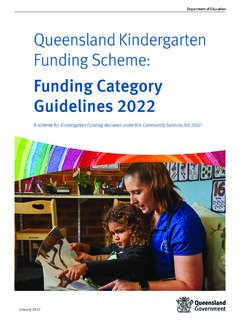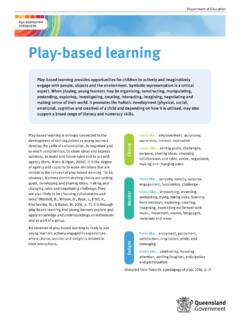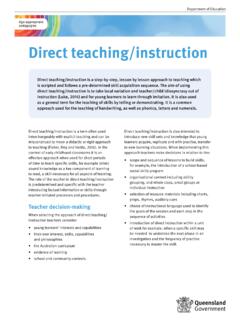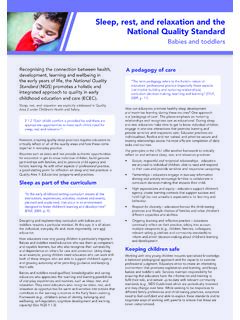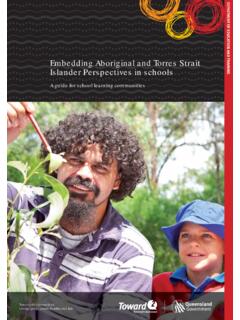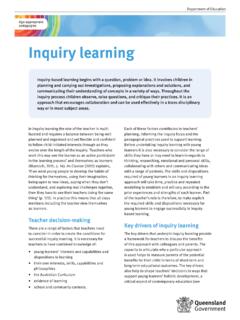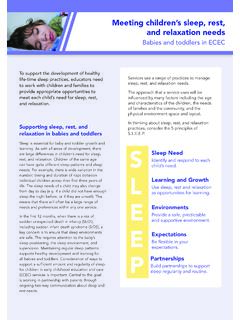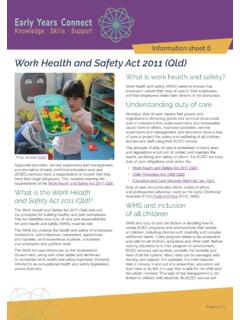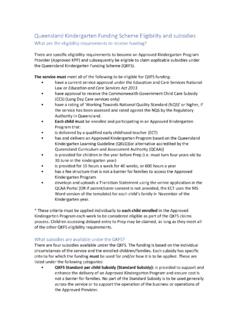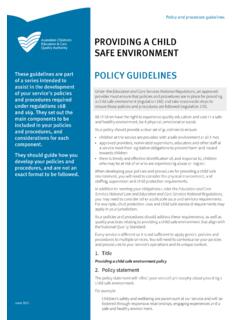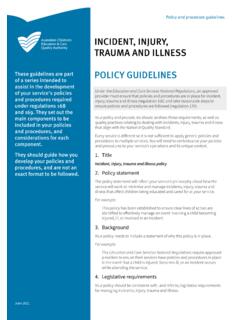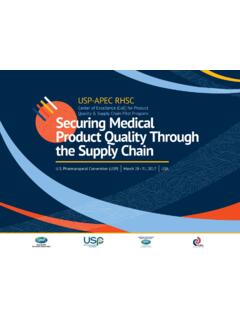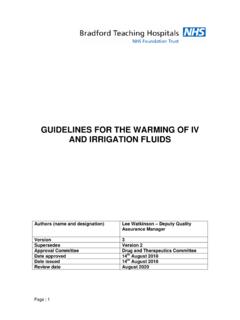Transcription of Incident, injury, trauma and illness policy guidelines
1 1 Children's health and safety Incident, injury, trauma and illness policy guidelinesINCIDENT, INJURY, trauma AND illness policy GUIDELINESU nder the Education and Care Services National Regulations, education and care services must have policies and procedures in place for incidents, illness , trauma and illness . These guidelines are part of a series and are intended to assist in the development of your Incident, injury, trauma and illness policy . They have been designed to guide you in the development of your policy and are not an exact format.
2 1. Title Incident, injury, trauma and illness policy2. policy statementThe policy statement will reflect your service s philosophy about the how the service will work to minimise and manage incidents, injury, trauma and illness that affect children being educated and cared for at your service. For example: This policy has been established to ensure clear lines of action are identified to effectively manage an event involving a child becoming injured, ill, or involved in an BackgroundYour policy needs to include a statement of why this requirement is in example, the Education and Care Services National Regulations require policies and procedures to be in place in the event that a child is injured, becomes ill, or an incident occurs while attending the s health, safety and wellbeing is paramount.
3 And education and care services have a responsibility to keep children being educated and cared for safe, while also providing opportunities crucial to a child s , the approved provider, nominated supervisor, educators and staff must ensure that every reasonable precaution is taken to protect children from any harm or hazard, as well as working to minimise and manage any incidents, injury, trauma and this regard, your service must have an Incident, injury, trauma and illness policy and procedures in place which are guided by your obligations under the Education and Care Services National Law and National 3 Children's health and safety Incident, injury, trauma and illness policy guidelinesChildren's health and safety Incident, injury, trauma and illness policy guidelines 24.
4 Legislative requirements Your policy must be consistent with and refer to legislative requirements for managing incidents, injury, trauma and illness . Examples include, but are not limited to:Section 165 Offence to inadequately supervise childrenSection 174 Offence to fail to notify certain information to Regulatory AuthoritySection 174 AFamily day care educator to notify certain information to approved providerReg 77 Health, hygiene and safe food practicesReg 85 Incident, injury, trauma and illness policies and proceduresReg 86 Notification to parents of incident, injury, trauma and illnessReg 87 Incident, injury.
5 trauma and illness recordReg 88 Infectious diseasesReg 89 First aid kitsReg 93 Administration of medicationReg 94 Exception to authorisation requirement anaphylaxis or asthma emergencyReg 95 Procedure for administration of medicationReg 97 Emergency and evacuation proceduresReg 103 Premises, furniture and equipment to be safe, clean and in good repairReg 104 FencingReg 117 GlassReg 161 Authorisations to be kept in enrolment recordReg 162 Health information to be kept in enrolment recordReg 167 Offence relating to protection of children from harm and hazardsReg 168 Education and care services must have policies and proceduresReg 169 Additional policies and procedures family day care serviceReg 170 Policies and procedures to be followedReg 171 Policies and procedures to be kept availableReg 172 Notification of change to policies or proceduresReg 177 Prescribed enrolment and other documents to be kept by approved
6 ProviderReg 183 Storage of records and other documentsWhen writing your policy , you will need to break down what is required under each Regulation and how your service will meet these requirements. How these work in practice will be contained in your you reflect on the Incident, injury, trauma and illness policy , it might highlight the need to split its various areas into different policies and procedures that can be readily accessed by all educators and staff to follow in relation to the service s philosophy and their roles and responsibilities. For example, you may wish to have separate policies for Dealing with serious incidents and Ongoing management of illness .
7 3 Children's health and safety Incident, injury, trauma and illness policy guidelines5. Principles to inform your policyAll decision-making should be carried out in accordance with the principles of your service s Incident, injury, trauma and illness policy . You may also like to consider your service s philosophy on play and the physical environment. Examples of principles could include, but are not limited to: The health, safety and wellbeing of children is a paramount consideration for our service. To help prevent any incidents, injury, trauma and illness , we will maintain high levels of supervision at all times and regularly review supervision plans.
8 At all times our educators and staff act with the utmost care and consideration. Therefore, in the event of an incident, injury, trauma or illness : we will carefully consider if there is a need for emergency services to be contacted; families will be notified of any impact on their child; and we will undertake a review (including a risk assessment) and take any appropriate action to remove or rectify the cause if required. Our service ensures that all our educators and staff are adequately equipped to undertake their role. In relation to incidents, injuries, trauma and illness , they receive relevant training, access to appropriate and up-to-date information, and regular professional development.
9 Confidentiality is of major importance and will be maintained at all Key termsTo make it easier for your audience, provide definitions of key terms that may not be used every day. For example:TermMeaningSourceACECQA Australian Children s Education and Care Quality AuthorityThe independent national authority that works with all regulatory authorities to administer the National Quality Framework, including the provision of guidance, resources and services to support the sector to improve outcomes for anaphylaxis management trainingAnaphylaxis management training approved by ACECQA and published on the list of approved first aid qualifications and training on the ACECQA Regulations (Regulation 136)
10 Approved emergency asthma management trainingEmergency asthma management training approved by ACECQA and published on the list of approved first aid qualifications and training on the ACECQA Regulations (Regulation 136)Approved first aid qualificationA qualification that includes training in the matters set out below, that relates to and is appropriate to children and has been approved by ACECQA and published on the list of approved first aid qualifications and training on the ACECQA are likely to include: Emergency life support and cardio-pulmonary resuscitation; convulsions; poisoning; respiratory difficulties; management of severe bleeding; injury and basic wound care; and administration of an auto-immune adrenalin Regulations (Regulation 136)EmergencyAn incident, situation or event where there is an imminent or severe risk to the health, safety or wellbeing of a person at the service.

